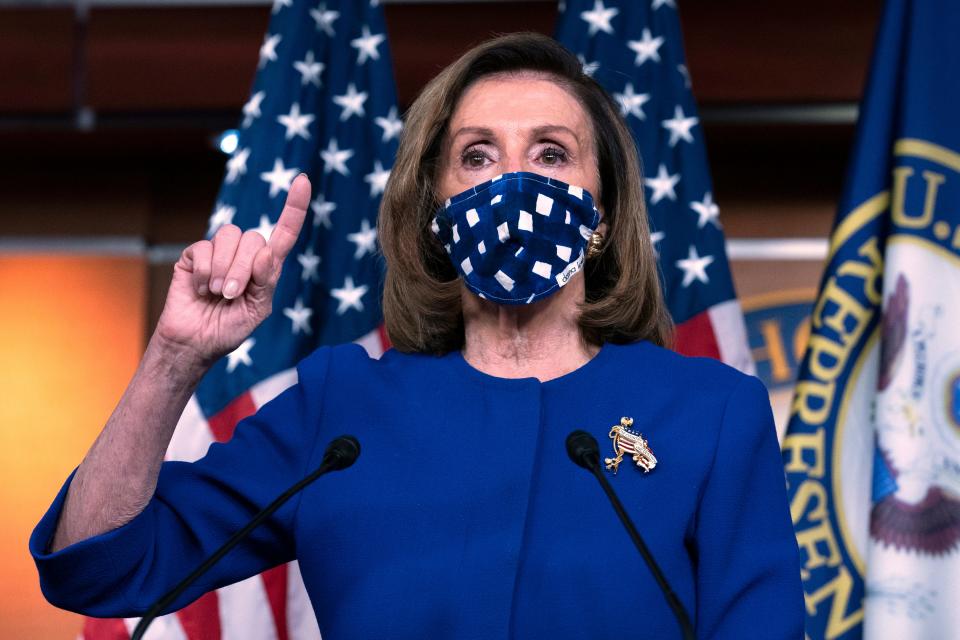2020 election surprises: Trump turnout, the missing blue wave and more
- Oops!Something went wrong.Please try again later.
WASHINGTON – No, there is no blue wave in the House. No, there's no Joe Biden blowout. And yes, lots of polls were wrong. Again.
The 2020 election is proving to be a nail biter, with presidential candidates still locked in a very tight battle by Wednesday morning, and both Democrats and Republicans making unexpected inroads in several races.
Here are some of the biggest surprises:
Too close to call: Presidential race between Trump, Biden remains close as battleground states count remaining ballots
Arizona turns blue
Arizona has turned blue for the first time in 24 years.
Democratic presidential candidate Joe Biden won Arizona, making him the first since Bill Clinton to carry what used to be a dependably red state. President Donald Trump won the state in 2016, by 91,000 votes or 3.5%.

And the Senate seat that the late Republican Sen. John McCain has held since 1987 will now belong to Democrat Mark Kelly. Kelly, a retired NASA astronaut, unseated Republican incumbent Martha McSally in a special election to fill the remainder of McCain's term.
With Kelly's victory, Arizona will be represented by two Democrats in the Senate, a significant shift in the state's political landscape, from red to purple to blue.
Arizona 2020 election updates: State turns blue, votes for Kelly, Biden; national race too close to call
Trump is performing better than expected
Regardless of who wins the White House, a couple of things are indisputable: Trump is performing better expected, which means polls were wrong. Again.
Trump is competitive in key swing states, with eyes on Wisconsin, Michigan, Pennsylvania, North Carolina and Georgia as election officials continue to count mail-in ballots. As of Wednesday morning, Biden is leading by the thinnest of margins in Wisconsin and Michigan. Trump is leading in North Carolina and Georgia, also by narrow margins. Pennsylvania, meanwhile, still has a ways to go from having a decisive winner.
The first sign that tamped down expectations of a Democratic blowout came Tuesday night, after Florida – a must-win state for Trump – was called for him. The president won Florida by a healthy 3.4% margin, with 96% of votes counted, even though poll after poll showed him trailing Biden.
Trump also won Ohio, another state that Democrats had hoped to flip. Biden showed early signs of strength there Tuesday night, but Trump ultimately won the state by a hefty 8.2% margin with 94% of votes counted.
A House blue wave? Not even a ripple
Democrats are expected to retain control of the House, but not because of a robust expansion that they had hoped. Instead, Democrats' control of the lower chamber — at 232-197 majority — is expected to narrow as Republicans show strengths in key districts.
Not a blue wave: Democrats are expected to retain control of the House, but it's not the broad expansion analysts predicted
Republicans have unseated freshmen incumbents in South Florida, New Mexico, Oklahoma and South Carolina, while successfully defending what looked to be vulnerable seats in Texas and elsewhere.
The GOP also unseated 15-term Democratic Rep. Collin Peterson of Minnesota.
The results are a stark contrast to 2018, when Democrats picked up key seats – many in suburban areas – and took control of the House.

Latinos turnout for Trump
It wasn't a surprise that Trump fared well among Cuban Americans in Florida's Miami-Dade County, the largest county in the state. Polls have shown that Biden was underperforming among Cuban Americans, who generally lean conservative, and Republicans have spent a lot of time trying to win that community.
Cuban Americans for Trump: Biden is getting trounced with Cuban American voters in Florida, a trend that could tip the state to Trump
The strong turnout from Cuban Americans in Miami-Dade helped hand Trump a victory in the state and helped GOP candidates win back two House seats that they lost in 2018.

That's significant and probably should alarm Democrats.
Miami-Dade County appears to be slowly moving away from its status as a liberal stronghold. Hillary Clinton carried the county in 2016 by nearly 300,000 votes or close to 30%. In 2020, that lead has shrunk significantly to less than 85,000 or 7%.
Susan Collins wins against all odds
Republican Sen. Susan Collins, who has built a career as a swing vote in many crucial Senate votes, was widely seen as among the most vulnerable incumbents in the Senate.
Democrats flooded Collins' home state with millions of dollars to help challenger Sara Gideon unseat the Maine Republican. Polls showed Collins trailing Gideon by a slim margin.
But the state turned out to be another disappointing loss for Democrats. Gideon announced Wednesday afternoon that she called Collins to concede.

Contributing: Christal Hayes, USA TODAY, the Palm Beach Post and the Arizona Republic
This article originally appeared on USA TODAY: 2020 election surprises: Trump turnout, the missing blue wave, more

